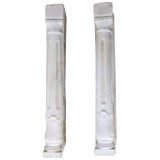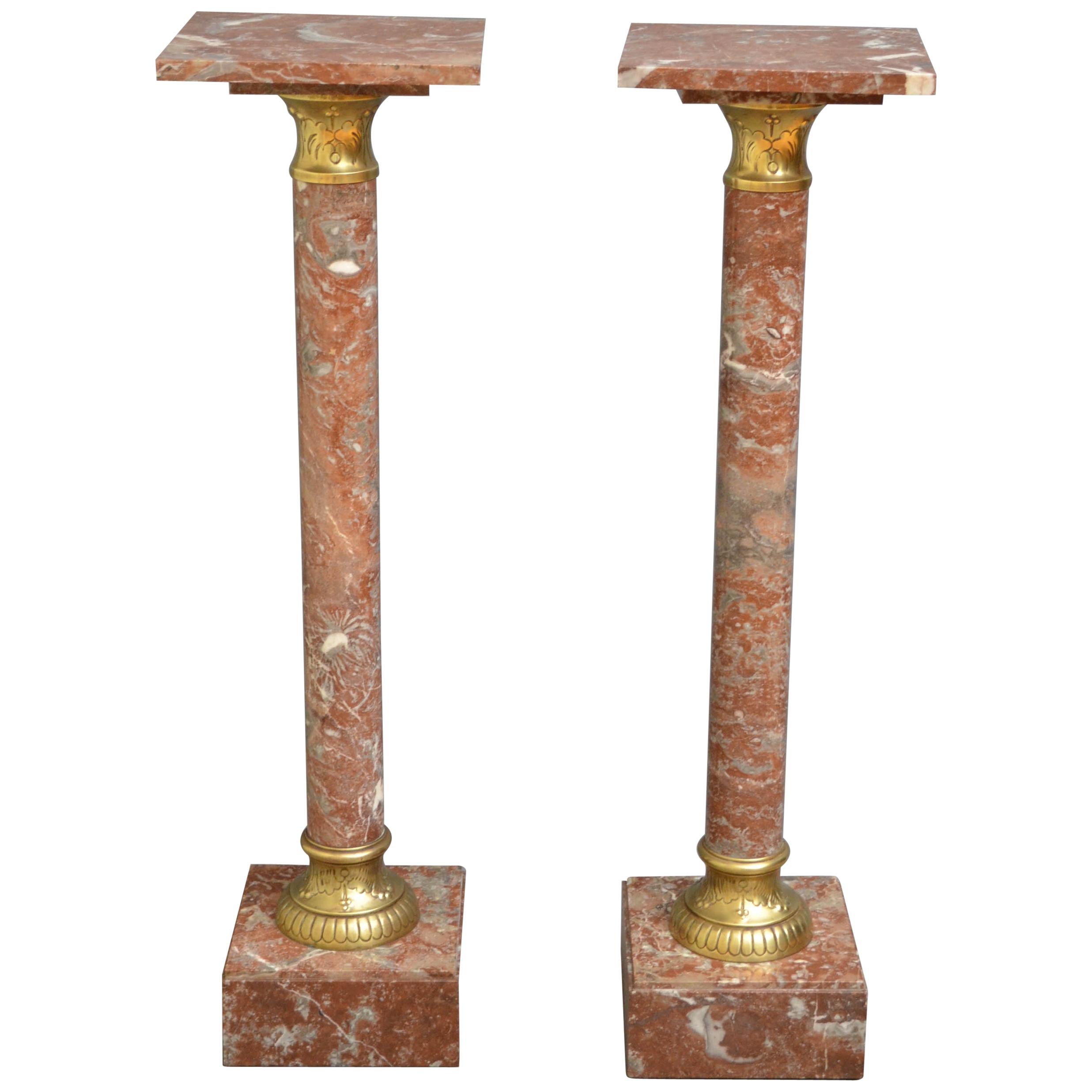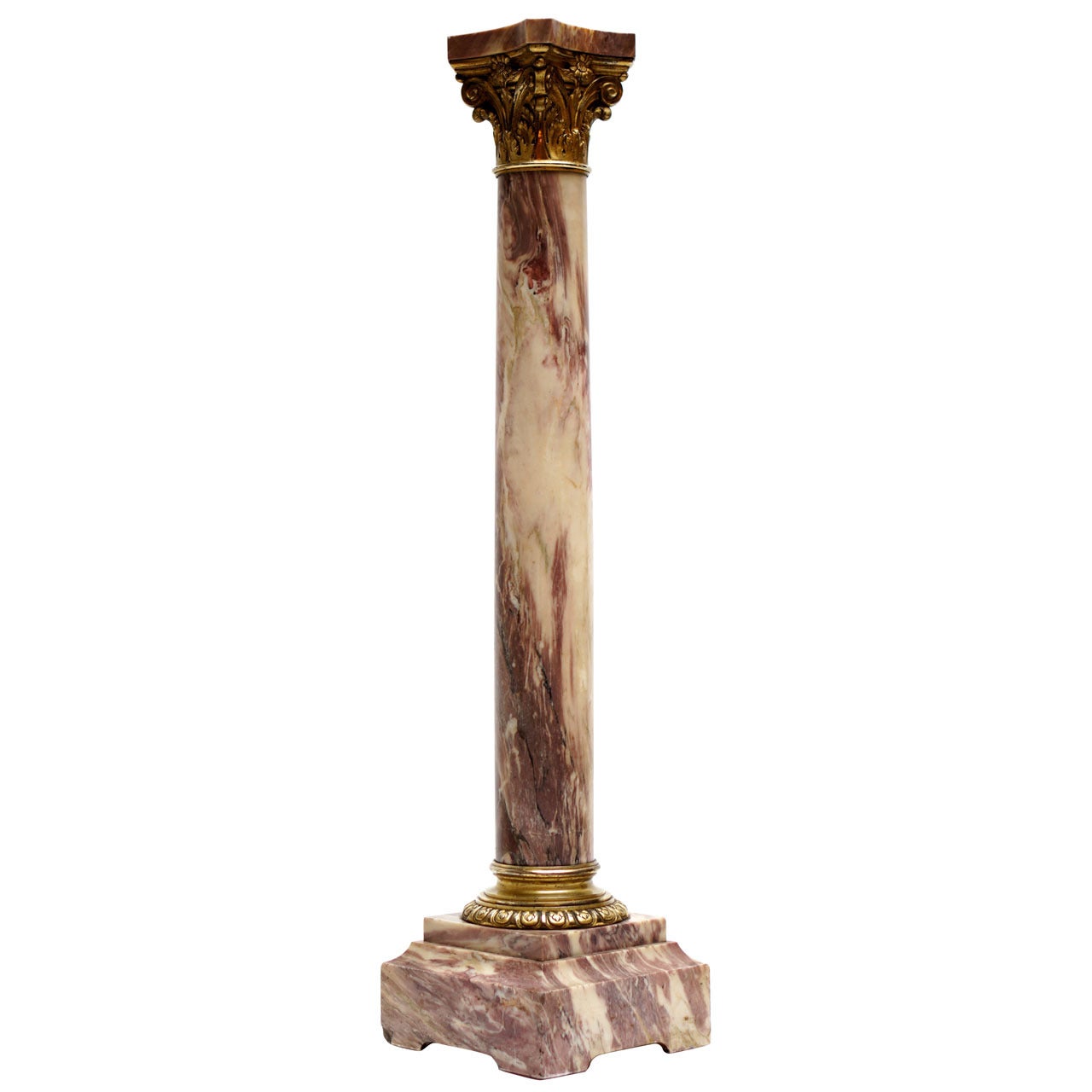Items Similar to Italian Ancient Botticino Marble Pair of Pinnacles, circa 1850
Video Loading
Want more images or videos?
Request additional images or videos from the seller
1 of 22
Italian Ancient Botticino Marble Pair of Pinnacles, circa 1850
About the Item
Pair of pinnacles
Northern Italy, mid-19th century
Botticino marble, carved
They measure 33.1 inches in height x 17.7 x 17.7 (84 cm x 45 x 45)
State of conservation: some visible cracks and various small gaps.
The two twin architectural elements of sculpted Botticino marble have a quadrangular base from which a chalice-shaped foot extends. Resting on this, a round pod-like element swells up to support a large pine cone. This is the main decoration: however, the other ornamental details enhance and embellish it, while exalting its position above, whether observed from afar or up close.
These aesthetic characteristics suggest that originally the pair of pinnacles were placed on columns or on architectural plinths, perhaps on the sides of a gate or at the end of a staircase at a noble palace with a certain level of importance; or as a decorative element along an avenue of some garden, such as at Villa Piaggio in Genoa, where the pine cones are arranged along the park entrance.
The use of the pine cone as an architectural decoration has ancient origins and derives from the complex symbolism which, from the representation of a divinity in a broad sense, gradually takes on the more specific meaning of fertility - linked to the phallic form - and therefore of birth and rebirth after death.
Present in many ancient cultures all over the world, the pine cone is used not only in architecture, but also in other decorative areas and over time it has become an esoteric symbol linked to the pineal gland, recognized as the seat of the soul and therefore as the highest degree of spiritual enlightenment.
In this way, the architectural use of the pine cone both on the doors and along the edge of the roof or on the sides of gates and stairways of patrician villas, has an obvious auspicious meaning.
The works presented here are made of Botticino marble, a metamorphic rock from the Mesozoic era.
The quarries are located in the province of Brescia and the best-known variety of this stone comes from that of Botticino: it has a light color and characteristic organic and inorganic inclusions which determine its homogeneous, compact and low-porosity composition. All this has favored its use in the creation of decorative outdoor elements of great value, since Roman times, as the Capitolium of the city of Brescia testifies.
Although the first certain information on the extraction of this marble dates back to the end of the sixteenth century, during the Renaissance period, there is mention of the existence of "master quarrymen" as early as the end of the 15th century. In the 18th century the extraction became professional and the demand for this product increased for use in large architectural works and noble palaces.
- Dimensions:Height: 33.08 in (84 cm)Width: 17.72 in (45 cm)Depth: 17.72 in (45 cm)
- Sold As:Set of 2
- Style:Other (Of the Period)
- Materials and Techniques:
- Place of Origin:
- Period:
- Date of Manufacture:circa 1850
- Condition:Wear consistent with age and use. Some visible cracks and various small gaps.
- Seller Location:Milano, IT
- Reference Number:1stDibs: LU4352221718112
About the Seller
4.3
Vetted Seller
These experienced sellers undergo a comprehensive evaluation by our team of in-house experts.
Established in 1860
1stDibs seller since 2018
19 sales on 1stDibs
Typical response time: 6 hours
Associations
International Confederation of Art and Antique Dealers' Associations
- ShippingRetrieving quote...Ships From: Milano, Italy
- Return PolicyA return for this item may be initiated within 14 days of delivery.
More From This SellerView All
- Ancient Italian Neoclassic Sterling Silver Coffee Pot, Milan, circa 1850Located in Milano, ITEmbossed and engraved sterling silver coffee pot Tommaso Panizza (1805-1868) Milan, circa half of the 19th century It measures 13.97 in (cm 35.5) in height x 8.66 in (22 cm) x 4.7...Category
Antique 1840s Italian Neoclassical Sterling Silver
MaterialsSterling Silver
- Ancient Pair of Italian Maiolica Dishes Milano, circa 1770By Felice ClericiLocated in Milano, ITTwo maiolica dishes, "Famille Rose" decoration Felice Clerici Factory Milan, 1770-1780 9.13 in (23.2 cm) each in diameter lb 1.32 (kg 0.6) State of conservation: perfect, except for...Category
Antique 1770s Italian Rococo Ceramics
MaterialsMaiolica
- Ancient Italian Pair of Armchairs in “Petit Point” Embroidery, Turin Circa 1750Located in Milano, ITPair of carved walnut armchairs covered in “petit point” embroidery Turin, circa 1750 They measure 33.8 in (86 cm) in height; 17.32 in (44 cm) in height to the seat; 25.98 in (66 cm...Category
Antique Mid-18th Century Italian Rococo Armchairs
MaterialsWool, Walnut
- Ancient Italian Walnut Mirror, Venice, Circa 1750Located in Milano, ITCarved, sculpted walnut mirror Venice, about mid-18th century It measures 53.93 x 33.46 in (137 x 85 cm); weight 30.86 lb (14 kg) State of conservation: slight gluing The walnut mirror has an elongated rectangular shape, crowned with a decorative three-lobed sculpted and carved molding. The frame encircles the mirror with a series of rabbet grooves. A rocaille carved molding is attached above, showing off its curved decorative elements. These descend along the sides of the mirror frame and are further enhanced with the presence of volutes "pennaccette", small leafy elements and minute buds. The mercury mirror is original. As a decorative element, mirrors represent a refined expression of the Rococo style in Venice around the middle of the XVIII century. During this period, decorated mirrors, previously use...Category
Antique 1750s Italian Rococo Wall Mirrors
MaterialsWalnut
- Pair of Ancient Italian Maiolica Flower Pots Milan, Rubati Factory, 1770 circaBy Pasquale RubatiLocated in Milano, ITMaiolica flower pot “a mezzaluna” decorated with trompe l’oeil Pasquale Rubati Factory Milan, circa 1770 Measures: each 4.7 in (cm 12) x 5 in (c...Category
Antique 1770s Italian Rococo Ceramics
MaterialsMaiolica
- Italian Ancient Marble Sculpture Fountain, Late 16th CenturyLocated in Milano, ITSea monster Carrara marble mouth fountain Italy, late 16th century It measures 13.8 x 31.5 x 18.9 in (35 x 80 x 48 cm) State of conservation: some small evident gaps and widespread signs of wear due to outdoor exposure. The gray marks crossing it do not come from restoration, but are rather the natural veins of the marble. This work has some morphological characteristics typically associated with the iconography of the sea monster: an elongated muzzle, sharp teeth, protruding eyes, elongated ears, and a coiled serpent's tail. An in-depth series of studies on artistic depictions of the sea monster attempted to verify how this symbol evolved in antiquity in the European and Mediterranean contexts and how it gradually changed its image and function over time. The iconography itself is mutable and imaginative and its history is rich with cultural and artistic exchange, as well as the overlapping of ideas. This occurred so much that it is difficult to accurately pinpoint the "types" that satisfactorily represent its various developments. However, we can try to summarize the main figures, starting from the biblical Leviathan and the marine creature that swallowed Jonah (in the Christian version, this figure was to become a whale or a "big fish", the “ketos mega”, translation of the Hebrew “dag gadol”). Other specimens ranged from the dragons mentioned in the Iliad (which were winged and had legs) to "ketos” (also from Greek mythology), the terrifying being from whose Latinized name (“cetus”) derives the word "cetacean". See J. Boardman, “Very Like a Whale” - Classical Sea Monsters, in Monsters and Demons in the Ancient and Medieval Worlds, in Papers presented in Honor of Edith Porada, Mainz am Rhein 1987, pp. 73-84). In Italy the monster underwent yet further variations: it can be found in Etruscan art on the front of some sarcophagi representing the companion of souls, while among the Romans we find the “Pistrice” (cited by Plinio in Naturalis Historia PLIN., Nat., II 9, 8 and by Virgilio in Eneide: VERG., Aen., III, 427), which appeared in the shape of a stylized hippocampus or a very large monstrous cetacean and evolved into a hideous being with a dragon's head and long webbed fins. During the Middle Ages, the sea monster was the object of new transformations: at this time, it is often winged, the head is stretched like a crocodile, the front legs are often very sharp fins - sometimes real paws - until the image merges with dragons, the typical figures of medieval visionary spirituality widely found throughout Europe (on this topic and much more, see: Baltrušaitis, J., Il Medioevo fantastico. Antichità ed esotismi nell’arte gotica, Gli Adelphi 1997). In Italy during the 15th and 16th centuries, the revival of classicism - representative of the humanistic and Renaissance periods - led to a different reading of these "creatures". Indeed, the sea monster was also to find widespread use as an isolated decorative motif, especially in numerous fountains and sculptures where dolphins or sea monsters were used as a characterizing element linked to water (on this theme see: Chet Van Duzer, Sea Monsters on Medieval and Renaissance Maps, London, The British library, 2013). From the morphological point of view, the "sea monsters" of this period are mostly depicted as hybrid figures, in which the body of a mythological or real being (a hippocampus, a sea snake, a dolphin), is joined to a head with a rather indistinct appearance. It was usually characterized by large upright ears, an elongated snout, sharp teeth and globular, protruding eyes; a complex and indefinite figure, both from the symbolic point of view and from that of its genesis. The work we are examining is placed as a cross between the medieval sea serpent and the Renaissance dolphin, with stylistic features which recall the snake as often used in heraldry (such as the "snake" depicted in the coat of arms of the Visconti - the lords and then dukes of Milan between 1277 and 1447 - and which, for some, may be derived from the representations of the “Pistrice” that swallowed Jonah). In the search for sources, Renaissance cartography and in particular woodcuts should not be neglected. See for example the monsters of Olaus Magnus, from the editions of the “Historia de gentibus septentrionalibus” (“History of the peoples of the north”) and the natural histories of Conrad Gesner, Ulisse...Category
Antique 16th Century Italian Renaissance Animal Sculptures
MaterialsCarrara Marble
You May Also Like
- Pair of Marble Columns, Italy, Late 19th CenturyLocated in Roma, ITPair of Marble Columns is an impressive original decorative object probably realized in the 19th century (bases are much older). Original very fine green marble and white marble (...Category
Antique Late 19th Century Italian Pedestals and Columns
MaterialsMarble, Carrara Marble
- Italian Pair of Fluted Column Pedestals, w/Original Faux Marble FinishLocated in Atlanta, GAAn Italian pair of carved-wood fluted column pedestals, with their original faux marble painted finish, from the mid 20th century. This pair of pedestals are circular-shaped, with fl...Category
Mid-20th Century Italian Pedestals and Columns
MaterialsWood
- Pair of Antique Marble Pilaster Console PlinthLocated in Sheffield, MAThe pair of antique stone console table supports or pedestals have finely carved fluted fronts topped by acanthus leaves set against uncarv...Category
Antique Early 19th Century French Classical Roman Architectural Elements
MaterialsMarble
- Victorian Pair of Marble ColumnsLocated in Whaley Bridge, GBK0370 Excellent pair of 19th century rouge, marble columns with brass collars. All in home ready condition, circa 1880 Measures: H 40.5” x W 11” x D 11” H 103 cm x W 28 cm x D 28 cm.Category
Antique 1880s European Victorian Architectural Elements
MaterialsMarble
- Italian Carrera Marble PedestalLocated in Essex, MAWell carved with associated square top, baluster form carved with leaves and birds, comes apart in three sections.Category
Antique 1870s Italian Neoclassical Revival Architectural Elements
MaterialsCarrara Marble
- Italian Marble Column Pedestal with Corinthian CapitalLocated in Antwerp, BEA marble column (pedestal) with a bronze Corinthian capital. Height 118 cm. Width 30 cm. Weight 68 kg.Category
Early 20th Century Italian Renaissance Revival Pedestals and Columns
MaterialsMarble, Bronze
Recently Viewed
View AllMore Ways To Browse
Form Architecture
Architectural Base
Marble Pair
Italian Architecture
Italy Architecture
Architectural Details
Ancient Italy
Ancient Italian
Ancient Italian Furniture
Ancient Carved
Organic Architecture
Ancient Architecture
Marble Architecture
Italian Marble Pair
Pair Of Italian Marble
Gardens Of Light
Ancient Marble
Roman Architecture





